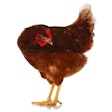
Since the start of this month, the HPAI risk level has been revised downwards by the veterinary authorities of France, Germany, and The Netherlands.
Latest assessment of the disease situation across France by the agriculture ministry has lowered to “negligible.” This is based on the low number of HPAI outbreaks in poultry flocks in the 2023-2024 winter season — just 10 nationwide — and none at all since January 16. This compares with 402 confirmed outbreaks over the previous season. Furthermore, the last wild bird infected with HPAI in France was identified in early January.
Back in mid-February, the French authorities officially declared the HPAI situation in the nation’s poultry “resolved.”
Across the Netherlands, the obligation to keep poultry and captive birds housed or caged has now been lifted nationwide.
At the end of March, the Dutch agriculture ministry had lifted these restrictions except in areas with the highest density of poultry farms.
In Germany, the HPAI risk level has also been reduced — for both poultry and wild birds — according to the national veterinary reference laboratory, Friedrich-Loeffler Institute (FLI).
Despite the apparent easing in this assessment, FLI recommends that protective measures remain in place for the time being.
Over recent weeks, the German veterinary agency has declared almost all of the ongoing HPAI outbreak series in commercial poultry “closed” to the World Organisation for Animal Health (WOAH). For the two northern states where the disease series remains unresolved for now, there have been no new cases since February.
Following the recent detection of cases of H5N1 HPAI infection in U.S. dairy cows, the FLI appears to be taking a more cautious approach to HPAI risk assessment.
France maintains momentum on HPAI vaccination
As of May 6, almost 32.5 million of the nation’s ducks had received their first dose of vaccine against HPAI, according to the French agriculture ministry.
Following devastating losses from HPAI in previous seasons, the nationwide vaccination campaign began in October of last year. It required the vaccination of all commercial ducks across mainland France except those producing products for export.
Vaccination has taken place in all regions. Numbers of ducks vaccinated so far have been highest in the main centers of duck farming in the west of the country. These are Pays de la Loire (14.24 million birds received their first vaccine dose), Nouvelle-Aquitaine (8.78 million), Occitania (3.79 million), and Bretagne (Brittany; 3.43 million).
Just one country reports new HPAI outbreak in poultry
So far this year, 147 HPAI outbreaks in commercial poultry flocks have been recorded in 16 European countries (as of May 5).
This is according to the Animal Disease Information System from the European Commission (EC). It monitors the disease situation in European Union (EU) member states and neighboring countries.
Since an earlier update dated April 19, the total number of outbreaks has risen by three. All of these were in Hungary.
Highest national total since the start of the year is 55 outbreaks in Moldova, followed by Poland (with 25), although neither country has added to its total since early March. Next comes Hungary, now with a total of 13 outbreaks for the year to date.
In 2023, the EC System recorded a total of 521 outbreaks in poultry across 24 countries.
Separately, the EC records HPAI outbreaks in non-commercial poultry, zoos, and similar premises in the category “captive birds.”
No new cases in this category have been reported since mid-March. At that time, seven countries had registered a total of 46 outbreaks affecting this population.
For comparison, 15 countries registered a total of 99 HPAI outbreaks in captive birds through the EC’s System during 2023.
Based on WOAH notifications, the H5N1 HPAI virus serotype was detected in the overwhelming majority of outbreaks in Europe’s poultry and captive birds during the 2023-2024 season.
4 European states report new cases in wild birds
Among their respective wild bird populations, only four countries had registered new cases with the EC or WOAH since mid-April.
As of May 5, the EC System had logged a total of 386 outbreaks in wild birds, with cases in 27 countries. These include Bulgaria, which registered its first wild bird case of 2024 late last month.
During the last week of April, one additional outbreak occurred in Germany and in Slovenia.
For comparison, 30 countries in Europe registered HPAI cases in wild birds with the EC in 2023 — 3,559 outbreaks in total.
The EC System no longer monitors the disease situation in Great Britain.
However, one further case linked to the H5N5 HPAI virus serotype was reported to WOAH in Scotland. It was a golden eagle found dead on Lewis in the Western Isles in October of last year.
View our continuing coverage of the global avian influenza situation.


















